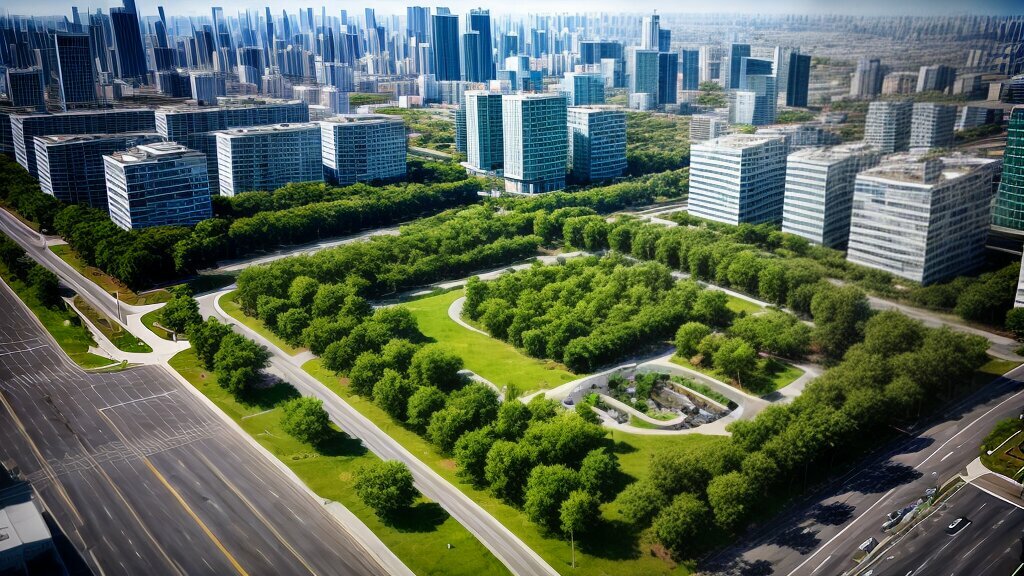Unveiling the Truth: Is Concrete Sustainable?
Concrete is a ubiquitous building material that is used in a wide range of construction projects, from sidewalks to skyscrapers. However, its environmental impact is a topic of debate, and many are questioning whether it is a sustainable option for future construction projects.
In terms of production, concrete involves the extraction of raw materials, transportation, and high energy consumption during the curing process. Additionally, the production of concrete generates significant carbon dioxide emissions, contributing to climate change. However, advancements in sustainable practices and materials have led to the development of eco-friendly concrete options.
As the construction industry moves towards sustainable development, it is crucial to consider the impact of building materials and implement sustainable design practices. In this article, we will explore the question of whether concrete is sustainable, and highlight sustainable practices and materials that can mitigate its environmental impact.
Key Takeaways:
- Concrete is a widely used building material, but its sustainability is a topic of debate.
- The production of concrete generates significant carbon dioxide emissions and involves high energy consumption.
- Advancements in sustainable practices and materials have led to the development of eco-friendly concrete options.
- Sustainable design practices and materials are crucial for reducing the environmental impact of concrete and ensuring sustainable development in the construction industry.
The Environmental Impact of Concrete
Concrete is a widely-used building material with a significant impact on the environment. The production of concrete contributes to the emission of greenhouse gases, depletion of natural resources, and generation of waste. As the construction industry works towards more sustainable practices, it is essential to consider the eco-friendliness of concrete and explore alternative building materials.
The carbon footprint of concrete is a significant concern. The production of cement, a key ingredient in concrete, requires high temperatures and high-energy input, leading to large amounts of carbon dioxide emissions. Concrete production is estimated to contribute to 7-10% of global carbon dioxide emissions. However, there are new eco-friendly concrete solutions that aim to reduce the carbon footprint of cement production and limit the impact of concrete on the environment.
One approach to reducing the environmental impact of concrete production is to incorporate alternative materials into the concrete mix. Researchers have developed low-carbon concrete mixes that use recycled or waste materials, such as fly ash, slag, and recycled aggregates. These materials can replace cement in the mix, reducing the carbon footprint of the concrete while retaining its structural properties. Additionally, the use of supplementary cementitious materials (SCMs), such as pozzolanic minerals, can reduce cement content and improve the durability of the concrete.
Sustainable construction practices can also mitigate the environmental impact of concrete. The use of eco-friendly building materials, such as bamboo, hemp, and straw bales, can reduce the need for concrete and limit its environmental impact. Additionally, energy-efficient building systems, such as green roofs, natural ventilation, and passive solar heating and cooling, can reduce the energy consumption and carbon footprint of concrete buildings.
The Future of Sustainable Concrete
The construction industry is continuously exploring new ways to make concrete more eco-friendly and sustainable. Research into new materials, such as graphene-enhanced concrete, is showing promising results in reducing the carbon footprint of concrete. Additionally, innovative techniques, such as 3D printing, are enabling faster and more efficient construction using sustainable concrete materials.
The drive towards sustainable development and green building practices is shifting the focus from standard concrete production towards more sustainable alternatives. By prioritizing environmentally-friendly construction practices, the industry can reduce the negative impact of concrete on the environment.

Advancements in Sustainable Concrete
The construction industry has been actively seeking new and innovative ways to reduce the environmental impact of concrete. Sustainable concrete refers to materials and techniques that aim to make concrete production and construction more eco-friendly.
One of the most significant advancements in sustainable concrete production has been the use of recycled aggregates. These are materials that have been crushed and sorted from construction and demolition waste. Using recycled aggregates in concrete production reduces the amount of waste sent to landfills and minimizes the need for new extraction of natural resources.
Another technique for producing sustainable concrete is the use of supplementary cementitious materials (SCMs). These are materials that are mixed with cement to alter the properties of the concrete and reduce its carbon footprint. For example, fly ash and slag are commonly used SCMs that can increase the strength and durability of concrete while reducing its carbon emissions.
Low-carbon concrete mixes are also gaining popularity in sustainable construction practices. These are formulations that use less cement or alternative binders that require less energy to produce, resulting in a lower carbon footprint. Additionally, low-carbon concrete mixes can improve thermal efficiency, contributing to eco-friendly construction practices.
| Advancements in Sustainable Concrete | Description |
|---|---|
| Recycled Aggregates | Using crushed and sorted construction and demolition waste in concrete production to reduce waste and minimize new extraction of natural resources. |
| Supplementary Cementitious Materials | Mixing materials like fly ash and slag with cement to alter properties and reduce carbon emissions. |
| Low-Carbon Concrete Mixes | Using less cement or alternative binders requiring less energy to produce to reduce carbon footprint and improve thermal efficiency. |
The use of sustainable concrete is essential for reducing the environmental impact of the construction industry. Concrete production and construction are significant contributors to carbon emissions and energy consumption, making it imperative to find new ways to make it more eco-friendly. Sustainable designs and architectural practices also play a crucial role in promoting sustainable construction practices.

As the industry continues to prioritize sustainability, advancements in sustainable concrete and construction practices will continue to evolve. It is crucial to consider sustainability when choosing building materials and implementing design practices to ensure a more eco-friendly future for construction.
The Role of Sustainable Design and Architecture
When it comes to enhancing the sustainability of concrete structures, sustainable design and architecture play a crucial role. By following the principles of sustainable design, buildings can reduce energy consumption, minimize waste, and promote eco-friendly practices.
One key aspect of sustainable design is energy efficiency. By using passive design strategies, buildings can reduce their reliance on artificial heating and cooling systems. This can be achieved by selecting appropriate building materials, such as concrete, that have high thermal mass and can store and release heat over time. In addition, buildings can be designed to maximize natural light and ventilation, thereby reducing the need for artificial lighting and air conditioning.
Another important consideration in sustainable design is the use of renewable resources. This includes selecting materials that are locally sourced and can be easily recycled or reused. Concrete is a highly durable material that can be recycled and repurposed for future use.
Examples of sustainable architecture that integrate concrete in environmentally friendly ways can be found around the world. One notable example is the Bullitt Center in Seattle, which was designed to be the greenest commercial building in the world. The building includes a number of sustainable features, such as a rainwater harvesting system, solar panels, and a composting toilet system. Concrete was used throughout the building for its durability and ability to regulate temperature.
Incorporating sustainable design and architecture into the construction of concrete structures is essential for reducing their environmental impact and promoting sustainable development. By using eco-friendly materials and practices, buildings can be constructed to be more energy efficient, environmentally friendly, and resource-efficient.

Conclusion
As we have explored in this article, the sustainability of concrete as a building material is a complex topic. While concrete production has a significant environmental impact, innovations in sustainable concrete are emerging to address this issue.
It is important for the construction industry to consider sustainable practices when choosing building materials and designing structures. Sustainable design principles, such as energy efficiency and natural ventilation, can enhance the sustainability of concrete structures.
As we continue to work towards sustainable development, the potential for concrete to play a role in sustainable construction cannot be overlooked. By embracing sustainable construction practices and supporting advancements in sustainable concrete, we can work towards a more environmentally responsible future.
FAQ
Q: Is concrete a sustainable building material?
A: Concrete has both positive and negative environmental impacts. While it is a durable and long-lasting material, the production of concrete involves a significant amount of energy consumption and carbon emissions. However, advancements in sustainable concrete and construction practices can help mitigate its environmental impact.
Q: What is the environmental impact of concrete?
A: Concrete production contributes to greenhouse gas emissions, primarily due to the release of carbon dioxide during cement production. Additionally, the extraction of raw materials for concrete can result in habitat loss and ecosystem disruption. However, sustainable construction practices and alternative materials can help reduce these environmental impacts.
Q: What advancements have been made in sustainable concrete?
A: There have been significant advancements in sustainable concrete, including the use of recycled aggregates, supplementary cementitious materials, and low-carbon concrete mixes. These innovations help reduce the carbon footprint of concrete and promote more sustainable construction practices.
Q: How does sustainable design contribute to the sustainability of concrete structures?
A: Sustainable design principles, such as energy efficiency, natural ventilation, and passive cooling, can enhance the sustainability of concrete structures. By integrating these principles into the design process, buildings can reduce their environmental impact and improve their overall sustainability.
Q: What is the role of sustainable architecture in sustainable concrete construction?
A: Sustainable architecture plays a crucial role in enhancing the sustainability of concrete construction. By incorporating sustainable design principles, architects can minimize the environmental impact of concrete structures and create more eco-friendly buildings.
Q: What is the importance of considering sustainability in building materials and design practices?
A: Considering sustainability in building materials and design practices is essential for reducing the environmental impact of the construction industry. By choosing sustainable building materials and implementing sustainable design practices, we can contribute to a more sustainable built environment.
Q: What are the ongoing efforts towards sustainable development in the construction industry?
A: The construction industry is actively working towards sustainable development by implementing green building practices, promoting sustainable materials, and embracing innovative technologies. These efforts aim to minimize the environmental impact of construction and create a more sustainable future.







